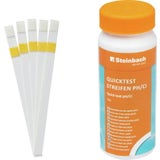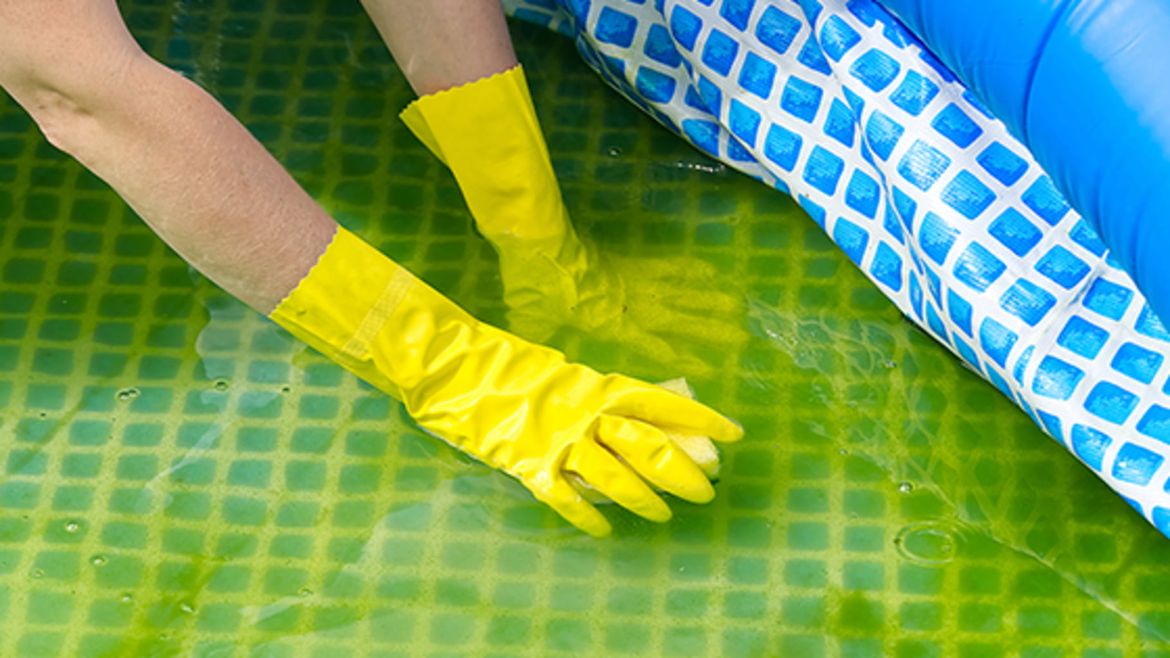Algae in Pool Water - The Route Back to Clear and Clean Water
Algae in the pool: crystal clear water in just a few steps
If your pool water is green, you probably have an algae infestation. If algae are already visible on the pool wall, or if the pool walls feel slimy to the touch, then you have an algae infestation. If your pool water is green because you filled it with well water and chlorinated it shortly thereafter, there is almost certainly a metal failure. This photo is an example of an acute algae infestation. In this guide, we will only discuss cases in which algae growth is the problem. We will show you how to clear up your pool water and also how you can avoid algae infestation in the future.
Green pool water - immediate measures
You must take immediate action because algae multiply very quickly. By the time real layers of algae have formed in the pool, the effort required to get rid of them is much higher than if you were only dealing with green water.
Step 1: Do a cleaning
For subsequent steps to be effective as quickly as possible, you must create the right conditions first.
- Immediately turn on your filter pump and let it run for the next 24-48 hours continuously.
- If using a cartridge filter system, rinse out your filter after every 6 hours or replace it with a new one.
- If using a sand filter, carry out an intensive backwash after 6 hours to permanently remove dirt from the pool water
- Remove coarse particles such as leaves, bugs, etc. using a net and vacuum the floor with a pool vacuum
- If algae deposits are visible on the walls, use a pool brush and loosen them on both the walls and the pool floor
Step 2: Prepare green pool water for shock chlorination
If the pool water is green, the overall water quality needs to be optimised. This step is necessary for subsequent steps using pool chemicals to give satisfactory results.
Determine pH value:
Check your pH value first. It is very important to accurately measure the pH value because errors can be result in the subsequent shock chlorination not being effective. The following applies to test strips and test tablets: Do not touch the test fields or test tablets with your fingers - skin oils can severely distort the results. For test strips, read the measurement result approx. 15-20 seconds after removing it from the water. For test tablets, only a few seconds after they have completely dissolved.
Adjust pH value
If your pH value is not between 7.0-7.4, then you need to adjust it with a pH-reducer or pH-raiser. In order to make the shock chlorination that follows as effective as possible, we recommend that you bring the pH value as close to 7.0 as possible.
Step 3: Pool cleaning with shock chlorination
At this step you add a comparatively large amount of chlorine granules to your green pool water to fight the algae. Since you've already removed other debris from the pool, your chlorine can focus entirely on the algae. BUT: You must dissolve the chlorine granules completely in a bucket separately first. Why? Because chlorine is very aggressive when it dissolves and would cause permanent bleaching stains on your pool liner. Therefore, proceed as follows: Fill a bucket with warm water - about 40°C, as this speeds up the dissolving process of the chlorine granules. Add chlorine granules according to your manufacturer's dosage recommendation. For example, Steinbach recommends using 200 grams of their chlorine granules per 10m³ of water. Once the granules are completely dissolved, pour the contents of the bucket into your pool - distribute it over different areas with the pump running.
Step 4: Fight algae in the pool with algaecide
One of the necessary measures to combat algae and algae spores and thus improve the water quality of your pool is the use of algaecide. Note that such a procedure also requires a pH value between 7.0 and 7.4. Now add some anti-algae according to the manufacturer's recommendation. Example: Steinbach Algicide: If the pool water is very green or there is a strong algae infestation, you can add up to 600 ml per 10m³ of water. If there are no algae or deposits visible on the pool walls, 200 ml per 10m³ of water should be sufficient.
Step 5: Optimise shock chlorination against green pool water
Algae love light and warm temperatures. Chlorine begins to break down when UV rays enter the water. Therefore one of our most important tips is to keep your pool covered with a tarpaulin. This is beneficial not only because a pool cover keeps UV rays out of the water but also helps keep the temperature of the water cooler. Algae thus get less light for photosynthesis. Depending on the circumstances, by covering your pool you can greatly increase the speed and efficiency of your chlorine - sometimes by 100% and more.
Gree pool water? Algae in the pool? Never again!
For long-lasting pool fun, it is essential to ensure water hygiene. This can only be achieved with effective pool care. You can prevent your pool water from turning green and keep algae infestations at bay by preventing algae from multiplying. But first, you need to understand what causes algae growth.
How does algae form in the pool?
Algae spores are almost always floating in the air and can therefore easily get into the water of your pool. If proper care is not taken, algae will feed on substances such as phosphates and nitrates contained in the dirt. They can grow rapidly, especially when the sun is strong and provides lots of light for photosynthesis. Incidentally, solar radiation also heats up your pool water, which can also promote strong algae growth. By the way, bacteria also love such conditions. Light and warmth are the most important factors. This is why algae infestations are more common in midsummer than in spring. And this connection is exponential - some pool owners are caught off guard at how quickly the quality of the pool water can be ruined.
These measures will help prevent algae infestation
The aim of good pool maintenance is to ensure that microorganisms such as algae, bacteria, viruses and fungi have no chance of spreading by a well-functioning cleaning and disinfection process.
Effective cleaning using a filter pump, net and pool vacuum is mandatory
Make sure that algae spores (and therefore bacteria etc.) are deprived of food. Dirt and debris objects such as leaves and insects contain many substances that algae can feed on. Therefore, make it a rule to clean your pool water regularly and thoroughly. Run your filter pump long enough. In midsummer, 7-8 hours is the minimum during the day. Filtration is not as effective at night as it is during the day. If you use glass or sand as the filter medium for a sand filter, supplement it with flocculants. Regularly clear your pool of objects that are floating on the surface or that have sunk to the bottom of the pool. Use pool nets for the water surface and floor nets or pool vacuum cleaners to remove coarse debris.
Know and set your water parameters to prevent your pool water from turning green again
Unfortunately, the water paramerts in many pools are inadequately monitored and adjusted. Beginners especially do not measure the pool water values often enough. Keep in mind that if there is not enough chlorine in the water and the pH value is not right, the pool will inevitably turn green. You should ensure the following values in the water:
- free chlorine 0.3-0.6 mg per litre
- pH between 7.0-7.4
- if possible, also determine the cyanuric acid level: 8-15ppm is ideal
If you are a beginner, measure your water parameters daily. If the pH value rises above 7.4, immediately bring it down with pH-Minus. Ideally, don't let it drop by more than 0.2 at a time.

How to keep pool water warm and avoid algae growth at the same time?
You can greatly reduce the amount of light entering your pool. Unfortunately, covering your pool with a tarpaulin causes the water temperature to drop. With a very dark pool solar film like this one at Poolpanda, you can keep your water warm and prevent algae infestation at the same time. Because no light means no photosynthesis!
Green pool water: Purify water with vitamin C?
Are you considering tackling an algae infestation with household products remedies instead of pool chemicals? Our answer is it's better if you don't. An algae infestation is an acute problem and needs to be solved immediately. Vitamin C is sometimes touted as a supposed solution. But watch out: the effects are not longlasting. The pool water will indeed become clearer but will turn green again after just a few days.
You can find more advice and video tutorials on how to deal with algae in your pool from the experts at Poolpanda.
Related products
-
 4.5 (22)
4.5 (22)Steinbach Quicktest Strips for pH Value and Free Chlorine, 1 Piece
- Fast and easy
- Intervene in a targeted manner
- Measure the pH and chlorine values of your pool
€ 8,29Delivery by April 25
-
 4.5 (22)
4.5 (22)Steinbach Test Kit for pH Value and Free Chlorine, 1 Piece
- Fast and easy
- Evaluate the result
- Intervene in a targeted manner
€ 9,99Delivery by April 25
-
 5.0 (7)
5.0 (7)Steinbach Bottom Net Attachment with Reinforced Plastic Frame, Bottom Net Attachment with Reinforced Plastic Frame
- With a deep mesh insert as standard
- Solid plastic nose
- High-quality
€ 19,09Delivery by April 25

